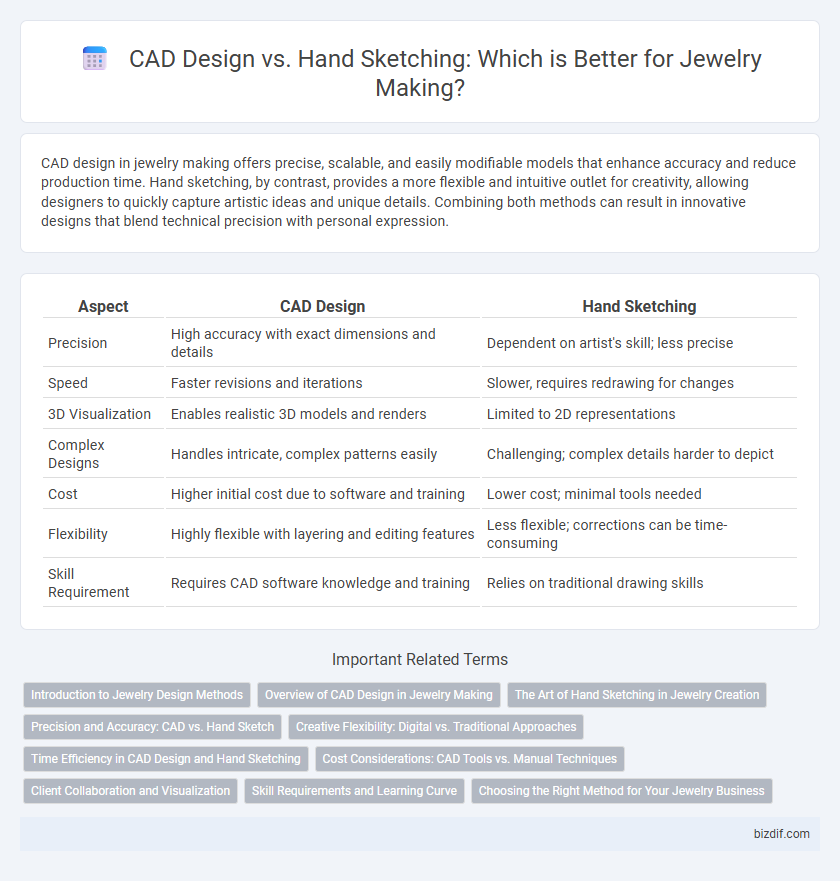CAD design in jewelry making offers precise, scalable, and easily modifiable models that enhance accuracy and reduce production time. Hand sketching, by contrast, provides a more flexible and intuitive outlet for creativity, allowing designers to quickly capture artistic ideas and unique details. Combining both methods can result in innovative designs that blend technical precision with personal expression.
Table of Comparison
| Aspect | CAD Design | Hand Sketching |
|---|---|---|
| Precision | High accuracy with exact dimensions and details | Dependent on artist's skill; less precise |
| Speed | Faster revisions and iterations | Slower, requires redrawing for changes |
| 3D Visualization | Enables realistic 3D models and renders | Limited to 2D representations |
| Complex Designs | Handles intricate, complex patterns easily | Challenging; complex details harder to depict |
| Cost | Higher initial cost due to software and training | Lower cost; minimal tools needed |
| Flexibility | Highly flexible with layering and editing features | Less flexible; corrections can be time-consuming |
| Skill Requirement | Requires CAD software knowledge and training | Relies on traditional drawing skills |
Introduction to Jewelry Design Methods
CAD design in jewelry making offers precision and repeatability, enabling intricate detailing and rapid prototyping with 3D modeling software. Hand sketching provides a more personal, artistic approach, allowing designers to quickly visualize and iterate original ideas on paper. Combining CAD and hand sketching enhances creativity and efficiency in the jewelry design process.
Overview of CAD Design in Jewelry Making
CAD design in jewelry making offers precise 3D modeling capabilities that enable designers to create intricate, detailed patterns with accuracy unattainable by hand sketching. The use of CAD software streamlines the prototyping process, allowing for easy modifications and virtual simulations before physical production. This technology enhances customization options and reduces material waste, promoting efficiency and innovation in jewelry craftsmanship.
The Art of Hand Sketching in Jewelry Creation
Hand sketching in jewelry creation offers unmatched artistic freedom, allowing designers to capture intricate details and personal flair that CAD design sometimes overlooks. This traditional method nurtures creativity and spontaneity, facilitating a direct connection between the artist's vision and the final piece. Jewelry artisans often rely on hand sketches as the foundational blueprint, enriching the design process with human touch and unique style.
Precision and Accuracy: CAD vs. Hand Sketch
CAD design in jewelry making offers superior precision and accuracy compared to hand sketching, enabling intricate detailing and flawless measurements. Digital tools allow exact replication and easy modification, reducing human error and enhancing design consistency. Hand sketching, while valuable for creative expression, often lacks the precision necessary for intricate or highly detailed jewelry pieces.
Creative Flexibility: Digital vs. Traditional Approaches
CAD design offers unparalleled creative flexibility with precise control over intricate details, allowing rapid iteration and easy modifications to complex jewelry designs. Hand sketching, while less precise, fosters organic creativity by enabling spontaneous expression and unique artistic nuances that digital tools may not replicate. Balancing CAD's technical advantages with the tactile inspiration of hand sketches enhances the jewelry design process, blending innovation with artistry.
Time Efficiency in CAD Design and Hand Sketching
CAD design significantly reduces the time required to create precise and detailed jewelry models by enabling rapid modifications and automated measurements. Hand sketching, while allowing creative expression, typically demands more time due to manual drafting and iterative refinement. The efficiency of CAD tools accelerates the design process, making them preferable for time-sensitive projects in jewelry making.
Cost Considerations: CAD Tools vs. Manual Techniques
CAD design in jewelry making often requires upfront investment in specialized software and hardware, which can be costly but reduces long-term expenses through precision and repeatability. Hand sketching minimizes initial costs due to its reliance on basic materials like pencils and paper but may lead to higher labor costs and longer design iterations. Choosing between CAD tools and manual techniques depends on budget constraints, production scale, and desired design complexity.
Client Collaboration and Visualization
CAD design in jewelry making enhances client collaboration through precise 3D modeling, enabling real-time modifications and detailed visualization that hand sketching cannot match. Clients gain a clearer understanding of design proportions, materials, and textures, leading to more informed decisions and higher satisfaction. Hand sketching offers artistic flexibility but lacks the interactive and accurate representation that CAD software provides for complex designs.
Skill Requirements and Learning Curve
CAD design in jewelry making demands proficiency with specialized software such as Rhino or Matrix, requiring a solid understanding of 3D modeling principles and computer-aided techniques. Hand sketching relies heavily on traditional drawing skills, an acute sense of proportion, and manual dexterity, often developed through years of artistic practice. The learning curve for CAD is steep initially due to technical complexity but allows precision and repeatability, while hand sketching offers intuitive creativity but requires extensive skill refinement for professional-level designs.
Choosing the Right Method for Your Jewelry Business
CAD design offers precision and scalability, allowing jewelers to create intricate, repeatable designs with efficient modifications in a digital workspace. Hand sketching provides a unique, artisanal touch and fosters creativity through freeform exploration, appealing to custom, one-of-a-kind jewelry pieces. Selecting the right method depends on factors such as production volume, design complexity, client customization needs, and the balance between traditional craftsmanship and modern technology in your jewelry business.
CAD design vs Hand sketching Infographic

 bizdif.com
bizdif.com